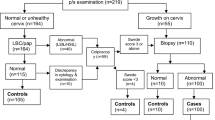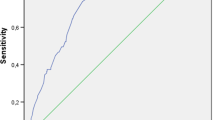Abstract
Trichomonas vaginalis is the most common nonviral sexually transmitted infection. According to the 2019 WHO cancer report, cervical cancer is the fourth most frequent cancer in women. However, previous research, which has not included a large-scale study to date, has revealed that Trichomonas vaginalis increases cervical cancer risk. In this study, we investigated a group of Asian females in Taiwan to determine the association between trichomoniasis and the risk of developing cervical lesions, including cancer, neoplasm, and dysplasia. We conducted a nested case-control study by using the National Health Insurance (NHI) program database in Taiwan. The International Classification of Diseases, 9th Revision classifications (ICD-9-CM) was used to categorize all of the medical conditions for each patient in the case and control groups. The adjusted odds ratio (AOR) and 95% confidence interval (CI) for the association between trichomoniasis and cervical lesions were estimated using multivariable conditional logistic regression to adjust for all comorbidities and variables. In total, 54,003 individuals were enrolled in the case group and 216,012 were enrolled in the control group. Trichomonas vaginalis exposure had a significant association with cervical lesions (AOR 2.656, 95% CI = 1.411–5.353, p = 0.003), especially cervical cancer (AOR 3.684, 95% CI = 1.622–6.094, p = 0.001). In patients with both trichomoniasis and depression, the relative risk increased 7.480-fold compared to those without trichomoniasis or depression. In conclusion, female patients with Trichomonas vaginalis exposure had a significantly higher risk of developing cervical lesions (especially cervical cancer) than those without exposure.


Similar content being viewed by others
Availability of data and materials
Data supporting the conclusions of this article are included within the article and its additional files. The datasets used and/or analyzed during the present study will be made available by the corresponding author upon reasonable request.
Abbreviations
- T. vaginalis :
-
Trichomonas vaginalis
- HPV:
-
human papillomavirus
- NHI:
-
National Health Insurance
- NHIRD:
-
National Health Insurance Research Database
- ICD-9-CM:
-
International Classification of Diseases, 9th Revision, Clinical Modification
- LHID 2000:
-
Longitudinal Health Insurance Database 2000
- NTD:
-
New Taiwan Dollars
- SD:
-
standard deviation
- CCI:
-
Charlson Comorbidity Index
- CCI_R:
-
Charlson Comorbidity Index remove
- AOR:
-
adjusted odd ratio
- CI:
-
confidence interval
- HR:
-
hazard ratio
References
Anderson BL, Cosentino LA, Simhan HN, Hillier SL (2007) Systemic immune response to Trichomonas vaginalis infection during pregnancy Sex Transm Dis 34:392–396 https://doi.org/10.1097/01.olq.0000243618.71908.95
Bachmann LH, Lewis I, Allen R, Schwebke JR, Leviton LC, Siegal HA, Hook EW III (2000) Risk and prevalence of treatable sexually transmitted diseases at a Birmingham substance abuse treatment facility. Am J Public Health 90:1615–1618. https://doi.org/10.2105/ajph.90.10.1615
Benabdelkader S et al (2019) Specific clones of Trichomonas tenax are associated with periodontitis. PLoS One 14:e0213338. https://doi.org/10.1371/journal.pone.0213338
Depuydt CE, Leuridan E, Van Damme P, Bogers J, Vereecken AJ, Donders GG (2010) Epidemiology of Trichomonas vaginalis and human papillomavirus infection detected by real-time PCR in flanders. Gynecol Obstet Invest 70:273–280. https://doi.org/10.1159/000314017
Donders GG, Depuydt CE, Bogers JP, Vereecken AJ (2013) Association of Trichomonas vaginalis and cytological abnormalities of the cervix in low risk women. PLoS One 8:e86266. https://doi.org/10.1371/journal.pone.0086266
Feng RM et al (2018) Risk of high-risk human papillomavirus infection and cervical precancerous lesions with past or current trichomonas infection: a pooled analysis of 25,054 women in rural. China J Clin Virol 99-100:84–90. https://doi.org/10.1016/j.jcv.2017.12.015
Ghosh I, Muwonge R, Mittal S, Banerjee D, Kundu P, Mandal R, Biswas J, Basu P (2017) Association between high risk human papillomavirus infection and co-infection with Candida spp. and Trichomonas vaginalis in women with cervical premalignant and malignant lesions. J Clin Virol 87:43–48. https://doi.org/10.1016/j.jcv.2016.12.007
Joseph Davey DL, Shull HI, Billings JD, Wang D, Adachi K, Klausner JD (2016) Prevalence of curable sexually transmitted infections in pregnant women in low- and middle-income countries from 2010 to 2015: a systematic review. Sex Transm Dis 43:450–458. https://doi.org/10.1097/olq.0000000000000460
King C et al (2008) Sexual risk behaviors and sexually transmitted infection prevalence in an outpatient psychiatry clinic sex. Transm Dis 35:877–882. https://doi.org/10.1097/OLQ.0b013e31817bbc89
Kovachev SM (2019) Cervical cancer and vaginal changes. Arch Microbiol. https://doi.org/10.1007/s00203-019-01747-4
Kulkarni S et al (2001) Cyclooxygenase-2 is overexpressed in human cervical cancer. Clin Cancer Res 7:429–434
Lara-Torre E, Pinkerton JS (2003) Accuracy of detection of trichomonas vaginalis organisms on a liquid-based papanicolaou smear. Am J Obstet Gynecol 188:354–356. https://doi.org/10.1067/mob.2003.8
Lazenby GB, Taylor PT, Badman BS, McHaki E, Korte JE, Soper DE, Young Pierce J (2014) An association between Trichomonas vaginalis and high-risk human papillomavirus in rural Tanzanian women undergoing cervical cancer screening. Clin Ther 36:38–45. https://doi.org/10.1016/j.clinthera.2013.11.009
Li C, Wu M, Wang J, Zhang S, Zhu L, Pan J, Zhang W (2010) A population-based study on the risks of cervical lesion and human papillomavirus infection among women in Beijing, People’s Republic of China. Cancer Epidemiol Biomarkers Prev 19:2655–2664. https://doi.org/10.1158/1055-9965.Epi-10-0212
Lin HC, Huang KY, Chung CH, Lin HA, Chen RM, Tsao CH, Chien WC, Chiueh TS (2019) Infection with Trichomonas vaginalis increases the risk of psychiatric disorders in women: a nationwide population-based cohort study. Parasit Vectors 12:88. https://doi.org/10.1186/s13071-019-3350-x
Mukanyangezi MF, Sengpiel V, Manzi O, Tobin G, Rulisa S, Bienvenu E, Giglio D (2018) Screening for human papillomavirus, cervical cytological abnormalities and associated risk factors in HIV-positive and HIV-negative women in Rwanda. HIV Med 19:152–166. https://doi.org/10.1111/hiv.12564
Olorunfemi G, Ndlovu N, Masukume G, Chikandiwa A, Pisa PT, Singh E (2018) Temporal trends in the epidemiology of cervical cancer in South Africa (1994-2012). Int J Cancer 143:2238–2249. https://doi.org/10.1002/ijc.31610
Pompili M et al (2017) Psychiatric comorbidity and suicidal ideation in psoriasis, melanoma and allergic disorders. Int J Psychiatry Clin Pract 21:209–214. https://doi.org/10.1080/13651501.2017.1301482
Shaio MF, Lin PR, Liu JY, Yang KD (1995) Generation of interleukin-8 from human monocytes in response to Trichomonas vaginalis stimulation. Infect Immun 63:3864–3870
Sperr M et al. (2018) Prevalence of comorbidities in periodontitis patients compared with the general Austrian population J Periodontol 89:19-27 https://doi.org/10.1902/jop.2017.170333
Thurman AR, Doncel GF (2011) Innate immunity and inflammatory response to Trichomonas vaginalis and bacterial vaginosis: relationship to HIV acquisition. Am J Reprod Immunol 65:89–98. https://doi.org/10.1111/j.1600-0897.2010.00902.x
Tzeng NS, Chang HA, Chung CH, Kao YC, Chang CC, Yeh HW, Chiang WS, Chou YC, Chang SY, Chien WC (2018) Increased risk of psychiatric disorders in allergic diseases: a nationwide, population-based, cohort study. Front Psychiatry 9:133. https://doi.org/10.3389/fpsyt.2018.00133
Waggoner SE (2003) Cervical cancer Lancet 361:2217-2225 https://doi.org/10.1016/s0140-6736(03)13778-6
World Health Organization (2019) Cervical cancer. World Health Organization https://www.who.int/cancer/prevention/diagnosis-screening/cervical-cancer/en/
World Health Organization DoRHaR (2012) WHO. Global incidence and prevalence of selected curable sexually transmitted infection
Yang S, Zhao W, Wang H, Wang Y, Li J, Wu X (2018) Trichomonas vaginalis infection-associated risk of cervical cancer: a meta-analysis. Eur J Obstet Gynecol Reprod Biol 228:166–173. https://doi.org/10.1016/j.ejogrb.2018.06.031
Zhang ZF, Begg CB (1994) Is Trichomonas vaginalis a cause of cervical neoplasia? Results from a combined analysis of 24 studies. Int J Epidemiol 23:682–690. https://doi.org/10.1093/ije/23.4.682
Zhang ZF, Graham S, Yu SZ, Marshall J, Zielezny M, Chen YX, Sun M, Tang SL, Liao CS, Xu JL, Yang XZ (1995) Trichomonas vaginalis and cervical cancer. A prospective study in China. Ann Epidemiol 5:325–332
Zhu Z, Zhao L, Brittingham A, Bai Q, Wakefield MR, Fang Y (2018) Trichomonas vaginalis inhibits hela cell growth through modulation of critical molecules for cell proliferation and apoptosis. Anticancer Res 38:5079–5086. https://doi.org/10.21873/anticanres.12827
Acknowledgments
We would like to thank the Health and Welfare Data Science Center, Ministry of Health and Welfare (HWDC, MOHW) for their support.
Funding
This work was supported by a grant from Tri-Service General Hospital, Taiwan (TSGH-C107-004; TSGH-C108-003; TSGH-B-109010) to WCC.
Author information
Authors and Affiliations
Contributions
RYS, LJH, WCC, and HCL conceived the idea and wrote the first draft of the manuscript. HYY, SSY, and CYC contributed to the manuscript. CHC contributed to the statistical analyses. All authors read and approved the final manuscript.
Corresponding authors
Ethics declarations
Competing interests
The authors declare that they have no competing interests.
Ethics approval
Not applicable.
Consent to participate
Not applicable.
Consent for publication
Not applicable.
Code availability
IBM SPSS V.22 (SPSS) was applied to analyze all data.
Additional information
Section Editor: Panagiotis Karanis
Publisher’s note
Springer Nature remains neutral with regard to jurisdictional claims in published maps and institutional affiliations.
Rights and permissions
About this article
Cite this article
Su, RY., Ho, LJ., Yang, HY. et al. Association between Trichomonas vaginalis infection and cervical lesions: a population-based, nested case-control study in Taiwan. Parasitol Res 119, 2649–2657 (2020). https://doi.org/10.1007/s00436-020-06759-4
Received:
Accepted:
Published:
Issue Date:
DOI: https://doi.org/10.1007/s00436-020-06759-4




